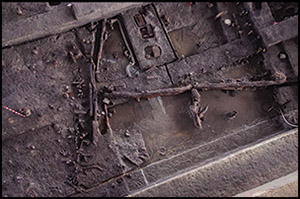Crossref Citations
This article has been cited by the following publications. This list is generated based on data provided by
Crossref.
Weisskopf, Alison
Deng, Zhenhua
Qin, Ling
and
Fuller, Dorian Q
2015.
The interplay of millets and rice in Neolithic central China: Integrating phytoliths into the archaeobotany of Baligang.
Archaeological Research in Asia,
Vol. 4,
Issue. ,
p.
36.
Fuller, Dorian Q
Weisskopf, Alison R
and
Castillo, Cristina Cobo
2016.
Pathways of Rice Diversification across Asia.
Archaeology International,
Vol. 19,
Issue. 1,
Castillo, Cristina Cobo
Bellina, Bérénice
and
Fuller, Dorian Q
2016.
Rice, beans and trade crops on the early maritime Silk Route in Southeast Asia.
Antiquity,
Vol. 90,
Issue. 353,
p.
1255.
Ma, Ting
Tarasov, Pavel E
Zheng, Zhuo
Han, Aiyan
and
Huang, Kangyou
2016.
Pollen- and charcoal-based evidence for climatic and human impact on vegetation in the northern edge of Wuyi Mountains, China, during the last 8200 years.
The Holocene,
Vol. 26,
Issue. 10,
p.
1616.
Jones, Sharyn
2016.
Anthropological Archaeology in 2015: Entanglements, Reflection, Reevaluation, and Archaeology beyond Disciplinary Boundaries.
American Anthropologist,
Vol. 118,
Issue. 2,
p.
301.
2016.
ANNUAL BIBLIOGRAPHY.
Early China,
Vol. 39,
Issue. ,
p.
331.
Jenkins, Emma
Jamjoum, Khalil
Nuimat, Sameeh
Stafford, Richard
Nortcliff, Stephen
and
Mithen, Steven
2016.
Identifying ancient water availability through phytolith analysis: An experimental approach.
Journal of Archaeological Science,
Vol. 73,
Issue. ,
p.
82.
Ball, Terry
Chandler-Ezell, Karol
Dickau, Ruth
Duncan, Neil
Hart, Thomas C.
Iriarte, Jose
Lentfer, Carol
Logan, Amanda
Lu, Houyuan
Madella, Marco
Pearsall, Deborah M.
Piperno, Dolores R.
Rosen, Arlene M.
Vrydaghs, Luc
Weisskopf, Alison
and
Zhang, Jianping
2016.
Phytoliths as a tool for investigations of agricultural origins and dispersals around the world.
Journal of Archaeological Science,
Vol. 68,
Issue. ,
p.
32.
2017.
First Islanders.
p.
218.
Allaby, Robin G.
Stevens, Chris
Lucas, Leilani
Maeda, Osamu
and
Fuller, Dorian Q.
2017.
Geographic mosaics and changing rates of cereal domestication.
Philosophical Transactions of the Royal Society B: Biological Sciences,
Vol. 372,
Issue. 1735,
p.
20160429.
Yang, Xiaoyan
Wang, Weiwei
Zhuang, Yijie
Li, Zhao
Ma, Zhikun
Ma, Yongchao
Cui, Yong
Wei, Jun
and
Fuller, Dorian Q
2017.
New radiocarbon evidence on early rice consumption and farming in South China.
The Holocene,
Vol. 27,
Issue. 7,
p.
1045.
Fuller, Dorian Q.
and
Stevens, Chris J.
2017.
Open for Competition: Domesticates, Parasitic Domesticoids and the Agricultural Niche.
Archaeology International,
Vol. 20,
Issue. 1,
Petrie, C. A.
and
Bates, J.
2017.
‘Multi-cropping’, Intercropping and Adaptation to Variable Environments in Indus South Asia.
Journal of World Prehistory,
Vol. 30,
Issue. 2,
p.
81.
Liu, Bin
Wang, Ningyuan
Chen, Minghui
Wu, Xiaohong
Mo, Duowen
Liu, Jianguo
Xu, Shijin
and
Zhuang, Yijie
2017.
Earliest hydraulic enterprise in China, 5,100 years ago.
Proceedings of the National Academy of Sciences,
Vol. 114,
Issue. 52,
p.
13637.
Premathilake, R
Anupama, K
Rajan, K
Prasad, S
Orukaimani, G
and
Yathees Kumar, V.P
2017.
Implications of phytolith records from an Early Historic megalithic burial site at Porunthal in Southern India.
Journal of Archaeological Science: Reports,
Vol. 11,
Issue. ,
p.
491.
Weisskopf, Alison
2017.
A wet and dry story: distinguishing rice and millet arable systems using phytoliths.
Vegetation History and Archaeobotany,
Vol. 26,
Issue. 1,
p.
99.
Jenkins, Emma Louise
Allcock, Samantha Lee
Elliott, Sarah
Palmer, Carol
and
Grattan, John
2017.
Ethno-geochemical and Phytolith Studies of Activity Related Patterns: A Case Study from Al Ma’tan, Jordan.
Environmental Archaeology,
Vol. 22,
Issue. 4,
p.
412.
He, Keyang
Lu, Houyuan
Zhang, Jianping
Wang, Can
and
Huan, Xiujia
2017.
Prehistoric evolution of the dualistic structure mixed rice and millet farming in China.
The Holocene,
Vol. 27,
Issue. 12,
p.
1885.
Hilbert, Lautaro
Neves, Eduardo Góes
Pugliese, Francisco
Whitney, Bronwen S.
Shock, Myrtle
Veasey, Elizabeth
Zimpel, Carlos Augusto
and
Iriarte, José
2017.
Evidence for mid-Holocene rice domestication in the Americas.
Nature Ecology & Evolution,
Vol. 1,
Issue. 11,
p.
1693.
2017.
First Islanders.
p.
267.
